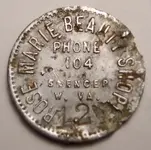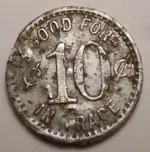An octagonal 5¢ variety is listed in Schenkman's WV Merchant Tokens book with the notation, "The only specimen seen (by the author) has been counterstamped '5' below 'W. Va.' on obverse."
I would suggest that the counterstamped number might be a serial number so the business somehow could keep track of the comings and goings of each token. Or, each operator in the beauty shop may have been assigned a number and was given a certain amount of tokens to give to potential customers. Then, as the tokens came in, the operator may have had to reimburse the shop. There probably are a lot of other logical explanations, but one might have had to be there at the time to understand for sure.
When were 3-digit telephone numbers used? They were used in the day of manual switchboards ("Hello, Central") and were replaced by seven digit numbers when a central switching office was installed to handle customer-dialed calls. That conversion came first in the big cities, but there were manual switchboards still in service in the 1970s. I don't recall when the last of them were replaced, but for the most part, exchanges were converted in the 1950s.
John in ID






